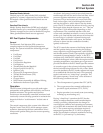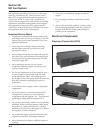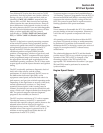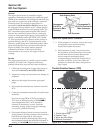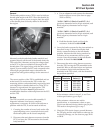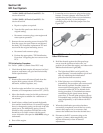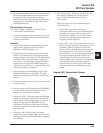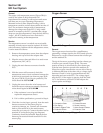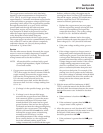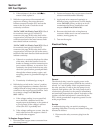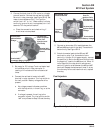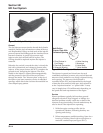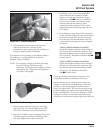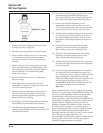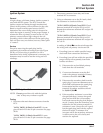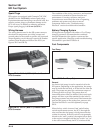
5B.11
Section 5B
EFI Fuel System
5B
The oxygen sensor can function only after being
heated by exhaust temperatures to a minimum of
375°C (709°F). A cold oxygen sensor will require
approximately 1-2 minutes at moderate engine load to
warm sufficiently to generate a voltage signal. Proper
grounding is also critical. The oxygen sensor grounds
through the metal shell, so a good, solid, unbroken
ground path back through the exhaust system
components, engine, and wiring harness is required.
Any disruption or break in the ground circuit can
affect the output signal and trigger misleading fault
codes. Keep that in mind when doing any
troubleshooting associated with the oxygen sensor.
The oxygen sensor can also be contaminated by leaded
fuel, certain RTV and/or other silicone compounds,
carburetor cleaners, etc. Use only those products
indicated as “O
2
Sensor Safe.”
Service
Like the other sensors already discussed, the oxygen
sensor is a non-serviceable component. Complete
replacement is required if it is faulty. The sensor and
wiring harness can be checked as follows.
NOTE: All tests should be conducted with a good
quality, high-impedance, digital VOA meter
for accurate results.
1. Oxygen sensor must be hot (minimum of 400°C,
752°F). Run engine for about 5 minutes. With the
engine running, disconnect the oxygen sensor
lead from the wiring harness. Set VOA meter for
DC volts and connect the red lead to the
disconnected sensor lead, and the black lead to
the sensor shell. Look for a voltage reading from
0.2 v-1.0 v.
a. If voltage is in the specified range, go to Step
2.
b. If voltage is not in the specified range,
reconnect the oxygen sensor lead. With the
lead connected, probe or connect the sensor
connection with the red VOA meter lead.
Attach the black VOA meter lead to a good
ground location. Start and run the engine at
3/4 throttle and note the voltage reading being
signaled by the oxygen sensor. The reading
should cycle between 0.2 v and 1.0 v, which
indicates the oxygen sensor is functioning
normally and fuel delivery is within
prescribed parameters. If the voltage readings
show a steady decline, rev the engine and
check the indicated reading again. If the
voltage momentarily increases and then again
declines, without cycling, the engine may be
running lean due to incorrect TPS initialization.
Shut off the engine, perform TPS initialization,
and then repeat the test. If TPS initialization
cannot be achieved, perform step c.
c. Replace the oxygen sensor (see next page).
Run the engine long enough to bring the new
sensor up to temperature and repeat the
output test from step 1. The cycling voltage
from 0.2 to 1.0 v should be indicated.
2. Move the black voltmeter lead to the engine
ground location and repeat the output test. The
same voltage (0.2 v-1.0 v) should be indicated.
a. If the same voltage reading exists, go on to
Step 3.
b. If the voltage output is no longer correct, a
badground path exists between the sensor
andthe engine ground. Touch the black lead at
various points, backtracking from the engine
ground back toward the sensor, watching for a
voltage change at each location. If the correct
voltage reading reappears at some point,
check for a problem (rust, corrosion, loose
joint or connection) between that point and
the previous checkpoint. For example, if the
reading is too low at points on the crankcase,
but correct voltage is indicated when the black
lead is touched to the skin of the muffler, the
flange joints at the exhaust ports become
suspect.
3. With the sensor still hot (minimum of 400°C,
752°F), switch the meter to the Rx1K or Rx2K
scale and check the resistance between the sensor
lead and the sensor case. It should be less than
2.0 K
ΩΩ
ΩΩ
Ω.
a. If the resistance is less than 2.0 K
ΩΩ
ΩΩ
Ω go to
Step 4.
b. If the resistance is greater than 2.0 K
ΩΩ
ΩΩ
Ω, the
oxygen sensor is bad, replace it.
4. Allow the sensor to cool (less than 60°C, 140°F)
and retest the resistance with the meter set on the
Rx1M scale. With sensor cool, the resistance
should be greater than 1.0 M
ΩΩ
ΩΩ
Ω.
a. If the resistance is greater than 1.0 M
ΩΩ
ΩΩ
Ω go to
Step 5.



